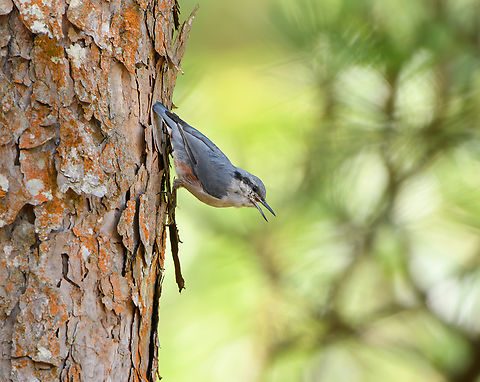
Appearance
The underparts are uniform grey to buff from the throat to belly, with brick red on the flanks. The undertail is white with a rufous border. The chestnut-vented nuthatch utters different kinds of calls, which can sometimes sound like a wren alarm, and its song is a monotonous, stereotypical crackle, typically "chichichichi".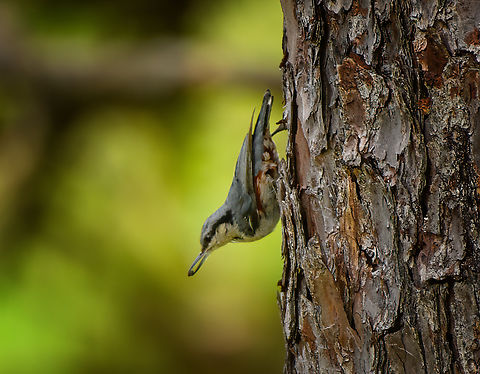
Naming
There are three accepted subspecies of the chestnut-vented nuthatch.⤷ "S. n. montium", described by the Irish ornithologist John La Touche as a montane taxon altitudinally separated from "S. europaea sinensis", it occurs in eastern Tibet, southern and eastern China, Myanmar, and northwest Thailand.
⤷ "S. n. nagaensis", occurs in the Naga Hills in northeastern India and northwestern Myanmar.
⤷ "S. n. grisiventris", described from Mount Victoria in western Myanmar, under the protonym "Sitta europaea grisiventris"; birds from southern Vietnam are also currently ascribed to this subspecies.
The subspecies "S. n. montium" was considered to possibly be the result of hybridisation between chestnut-vented nuthatch and the Chinese subspecies of Eurasian nuthatch "Sitta europaea sinensis", or at least to be able to interbreed with it. This is possibly due to the fact that the type series of "S. e. sinensis" was composite and included a specimen of the chestnut-vented nuthatch. For these reasons, Jean-François Voisin and colleagues designated a lectotype in 2002 for the name "Sitta sinensis". The attribution of the populations of western Myanmar and southern Indochina to the same subspecies "S. n. grisiventris", with "S. n. montium" in central Myanmar between these populations seems untenable, and their taxonomy has yet to be verified.The range of the chestnut-vented nuthatch overlaps with that of the Burmese nuthatch. However, the chestnut-vented nuthatch is easily distinguished by the colour of its underparts, and the lack of contrast between the sides of the head and the throat, whereas the other species has white chins, cheeks, and parotid region contrasting with brick-red to orange-brown underparts. However, in the chestnut-vented nuthatch, some individuals in fresh plumage may have underparts almost as buff as some Burmese nuthatch females or juveniles. The chestnut-vented nuthatch can then be recognised by its darker, duller blue upperparts, by its red flanks contrasting with the buff, and by its undertail, with feathers edged with red giving a "scales" pattern, when they appear almost uniformly white in the Burmese nuthatch.
The subspecies "S. n. montium" can also be confused with the subspecies "S. e. sinensis" of the Eurasian nuthatch where they coexist in Sichuan and Fujian. As the latter subspecies has more orange underparts, some Eurasian females may be difficult to differentiate from chestnut-vented nuthatches in fresh plumage. The two species can be distinguished by their vocalisations, with chestnut-vented nuthatch lacking the characteristic singing "dwip" of the Euraisan nuthatch. Hybrids between these two taxa have been suggested, with montane populations of "S. e. sinensis" being, like the chestnut-vented nuthatch, greyer on the underside, darker above, and larger than lowland individuals. The chestnut-vented nuthatch, however, is even greyer, and does not have the whitish cheeks of the Eurasian nuthatch.
In southwest China, the chestnut-vented nuthatch lives within the range of the Yunnan nuthatch. However, the latter is smaller, has a thin white supercilium, and has plain, pale buff underparts with no russet on the flanks. In northeastern India and northwestern Myanmar, the chestnut-vented nuthatch can also be confused with the white-tailed nuthatch; both species share similar habitats. The white-tailed nuthatch, however, has a white spot on the top of the middle rectrices, and has more orange underparts, without brick-red flanks or white spots on the undertail. The giant nuthatch, whose distribution overlaps with that of the chestnut-vented nuthatch in India, Myanmar, and Thailand, differs from the latter in being much larger in size, having a finer eyestripe, and having a crown that is much lighter than the rest of the mantle.
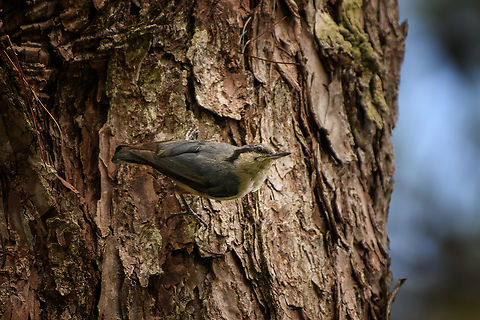
Distribution
The chestnut-vented nuthatch lives from Tibet to the mountains of Lâm Đồng province in southern Vietnam. In India, it is found only in the far eastern states of Arunachal Pradesh, Nagaland, Manipur, Assam and Meghalaya. The species lives in the Chin Hills of western Myanmar, but most of its distribution in Myanmar is in the eastern half of the country, from Kachin State to at least Shan State, and also into northwestern Thailand. It also nests in Tibet and south-central China, from western Sichuan to Yunnan and marginally in southwestern Guizhou. An isolated Chinese population also lives in northwestern Fujian, on Mount Huanggang. Two other isolated populations from the southernmost part of the species' distribution, one occurring in southern Vietnam on the Đà Lạt Plateau, another being reported in Laos on the Bolaven Plateau.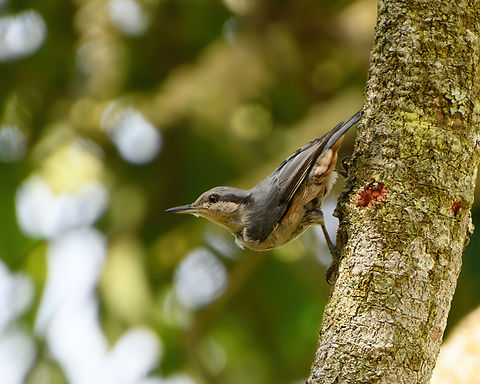
Status
The population of the chestnut-vented nuthatch is declining due to habitat destruction and fragmentation, but its range is large and was estimated to be 3.8 million km2, and the species is generally common throughout its range. For these reasons, the chestnut-vented nuthatch is considered to be of least concern by the International Union for the Conservation of Nature. A study carried out in 2009 tried to predict the impact of climate change on the distribution of several species of nuthatches in Asia by modeling two scenarios. It predicted that the chestnut-vented nuthatch could see its distribution decrease between the 2040s and 2069 by 15.9 to 17.4%.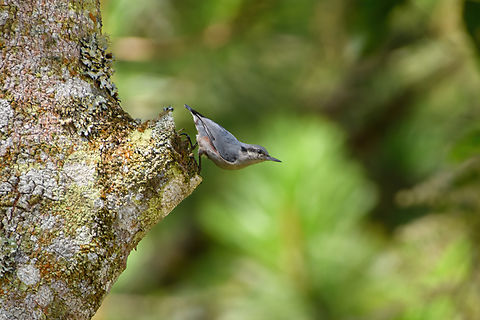
Behavior
The chestnut-vented nuthatch generally lives alone or in pairs, but joins mixed-species foraging flocks outside of the breeding season. In winter, it can thus be observed in the company of different species of tits such as the yellow-cheeked tit, bushtits, woodpeckers, alcippes, and minlas.Habitat
The chestnut-vented nuthatch usually inhabits evergreen forests of the uplands, or forests and pine patches growing on dry ridges in the middle of evergreen forests. Locally, it also occurs in deciduous forests in northeastern India, in "Quercus subsericea" oak forests and alder groves in northeastern Myanmar, spruce forests, fir forests or rhododendron stands in Yunnan, or poplar and walnut in Sichuan. The altitudinal distribution ranges from 1,400–2,600 m in India, Thailand, and Myanmar, occasionally occurring up to 3,200 m in the latter. It also occurs from 1,050–3,500 m in Tibet and Sichuan and up to 4,570 m in Yunnan. The population in southern Vietnam lives between 915–2,285 m.Reproduction
Although the breeding season varies by region, it generally takes place in Thailand from March to May, March to June for India, April to early June for eastern Myanmar, and April to May in Fujian. On Nat Ma Taung, juveniles have been observed as early as March 31. According to observations made in Thailand and Vietnam, the construction of the nest begins in January. It is located at a height of about 10 m in the hole of a tree, or in a stump.The chestnut-vented nuthatch, like the Eurasian nuthatch and other species of the family, may line the entrance of a cavity with mud to reduce the opening and thus avoid predation of the brood. The bottom of the nest is lined with pieces of bark and moss and topped with hair. Two to five eggs are laid, averaging 18.6 mm × 13.8 mm in "S. n. nagaensis" and 18.3 mm × 14 mm in "S. n. montium". They are white, with red dots on a mottled reddish-purple background, the red dots mainly concentrated at the larger end of the egg.
Food
The chestnut-vented nuthatch often forages for food on the ground, on rocks, old stumps, or in trees. No specific information about the diet is known, but the species probably feeds on small arthropods and seeds.Predators
The population of the chestnut-vented nuthatch is declining due to habitat destruction and fragmentation, but its range is large and was estimated to be 3.8 million km2, and the species is generally common throughout its range. For these reasons, the chestnut-vented nuthatch is considered to be of least concern by the International Union for the Conservation of Nature. A study carried out in 2009 tried to predict the impact of climate change on the distribution of several species of nuthatches in Asia by modeling two scenarios. It predicted that the chestnut-vented nuthatch could see its distribution decrease between the 2040s and 2069 by 15.9 to 17.4%.References:
Some text fragments are auto parsed from Wikipedia.